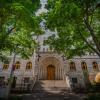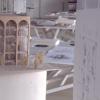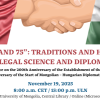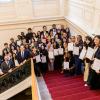Galactic pioneers of the future
2025
Jun
12
Can we really create a human colony on Mars? Can we find an Earth-like planet? Will we go on holiday to the Moon in the future? The main theme of this year's Space Challenge 2025, organised by the Pécs Cultural Centre, was "human life beyond Earth". On 12 June, the winners received their prizes worth HUF 4 600 000 in the Senate Hall of the University of Pécs (PTE), one of the main sponsors of the competition.
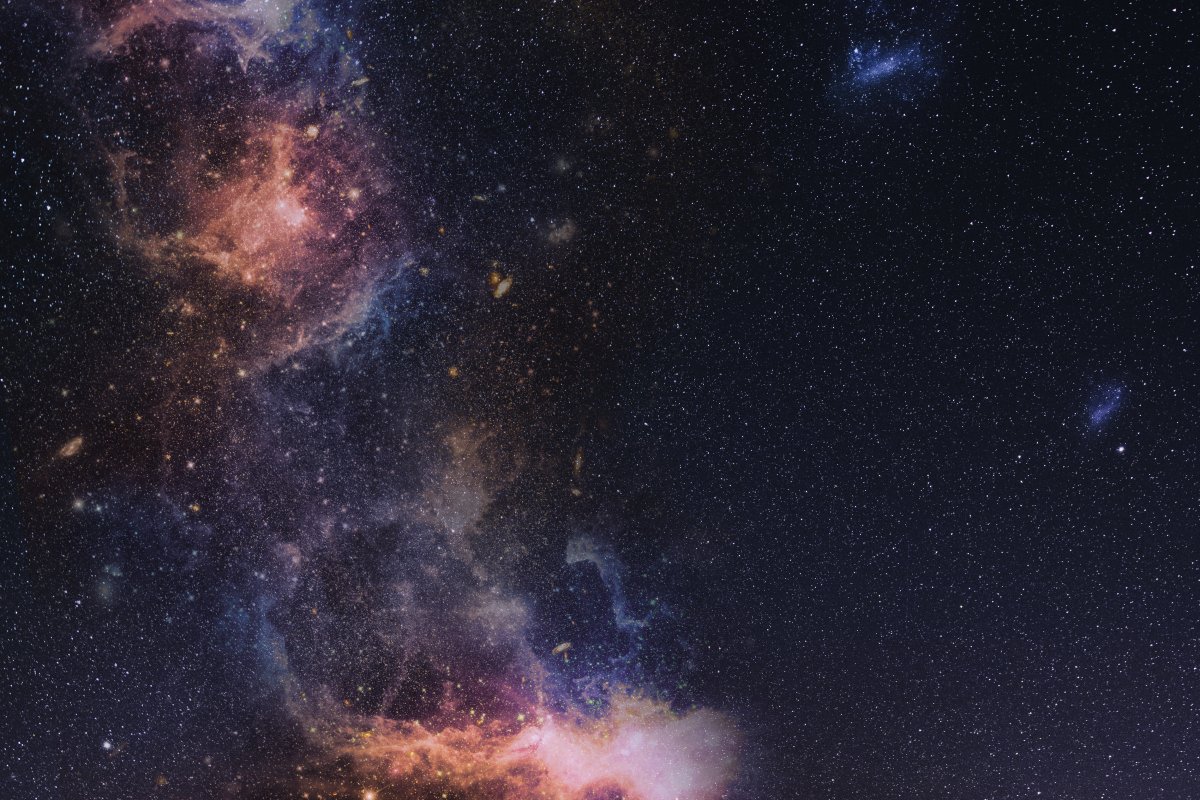
Many people have wondered whether humans could establish colonies outside the Earth. The Space Challenge competition, supported by PTE and the Ministry of Foreign Affairs and Trade, explored this very question. Winners have included entries such as creating a Mars base, solving the space debris problem, making a smart-spacesuit, or creating life on the Moon with ingenious and innovative developments.
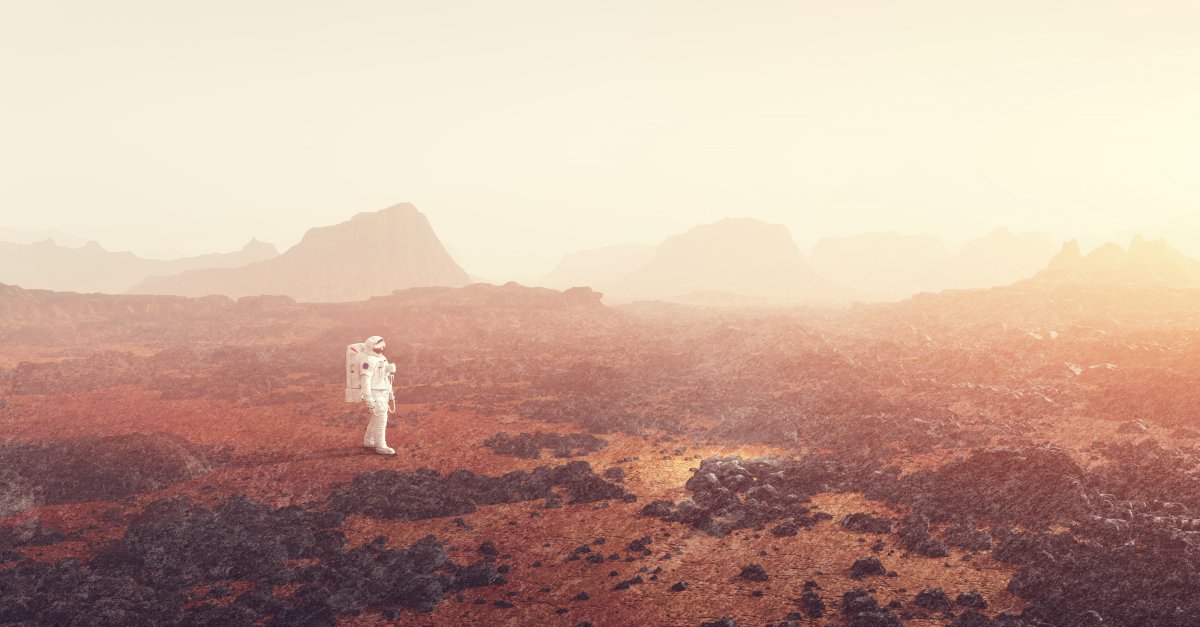
The competition, which started in 2019, was initially organized only at the regional level, but has grown into a nationwide talent development competition affecting technical culture. Applicants in four age groups – from 5th-6th and 7th-8th graders who are open to space exploration, through high school explorers to university innovators – were able to submit their entries anonymously, so that only the power of the idea could speak for them. This year, nearly 100 teams submitted their entries.
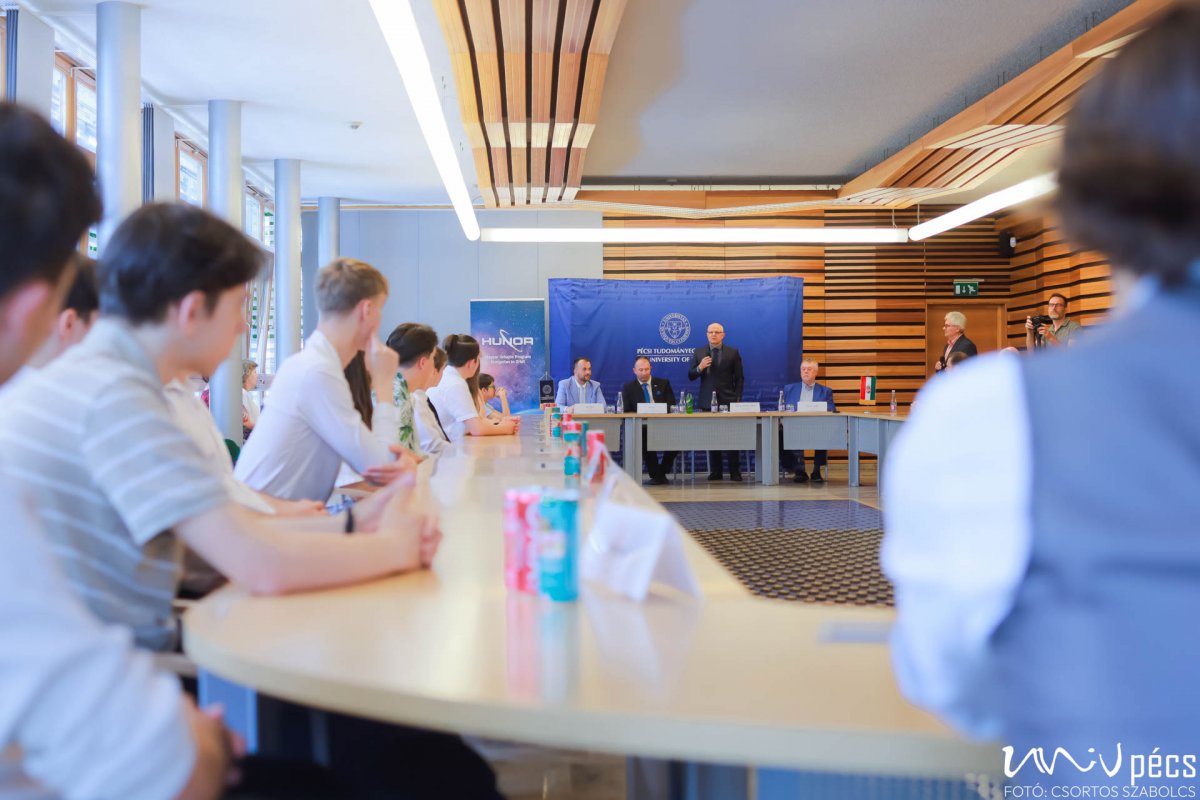
At the award ceremony, Dr. András Komócsi, the Vice-Rector for Science at PTE, called on Hollywood films to help illustrate space. He humorously suggested that the younger generation has to watch 2001: A Space Odyssey. In his opening speech, he emphasized that “science is when we look up to the sky and begin to wonder what this life is like around us… Science can have three great goals: to understand and overcome diseases, to uncover human evil, and to make space our home.” Then he concluded his speech with the words of the American astronomer Carl Sagan:
“Man is the instrument of the universe for the universe to learn about itself.”
He added, “The fact that we research, the fact that we form teams that aim to uncover these secrets, I can’t imagine a more beautiful and lofty goal than that.”
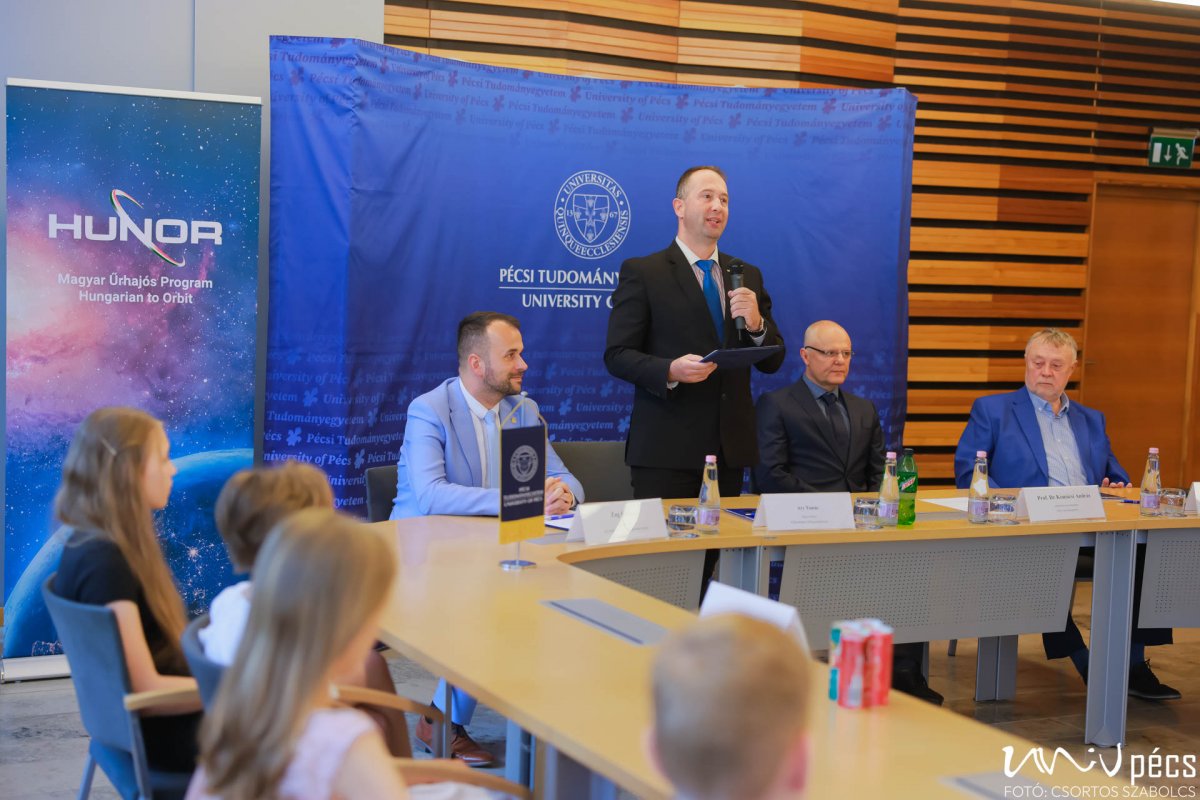
Tamás Ary, the space officer of the department responsible for the HUNOR - the Hungarian Astronaut Program of the Ministry of Foreign Affairs and Trade, invited the attendees to a historical tour with his speech. He highlighted that there are currently 140 Hungarian-developed or manufactured space tools in space. “We can talk about Hungarian space exploration for eight decades… In 1946, Zoltán Bay and his team first measured the distance between the Earth and the Moon, the same year as in the United States. Then, in 1980, Brigadier General Bertalan Farkas, the first Hungarian astronaut, traveled into space, and
Hungary thus became the seventh nation on Earth to send an astronaut into space.”
Soon, another Hungarian will visit space, as mechanical engineer Tibor Kapu will begin his 14-day mission in the coming days, where he will conduct 29 scientific experiments on the International Space Station thanks to the HUNOR (Hungarian to Orbit) - Hungarian Astronaut Program. Out of 247 applicants, one and his reserve were selected for this program, who can follow in the footsteps of the great Hungarian astronauts.
Among the applicants was Dr. Ádám Schlégl, a researcher, orthopedic specialist, and teacher at the University of Pécs, who got into the top 4 candidates
and who is still actively participating in the HUNOR program today.
“Hungarian universities – including the University of Pécs – have joined forces in order to coordinate their activities in the field of space research, both in terms of education and research, to move forward more effectively, and to innovate.” – highlighted the space officer, emphasizing the key role of Hungarian universities in innovation, and then added that
in 2021, the UniSpace Hungary consortium was established, of which PTE is also a member,
within which postgraduate space training courses were launched in Hungarian and English.
“This is the field that can fulfill researchers’ dreams… It not only gives respect, but also innovative, knowledge-intensive, added value that helps the progress of human civilization,” said Tamás Ary, who, at the end of his speech encouraged students to enter a research career, because space is still waiting to be discovered.
“Think, believe, dream, and dare!” he urged those present.
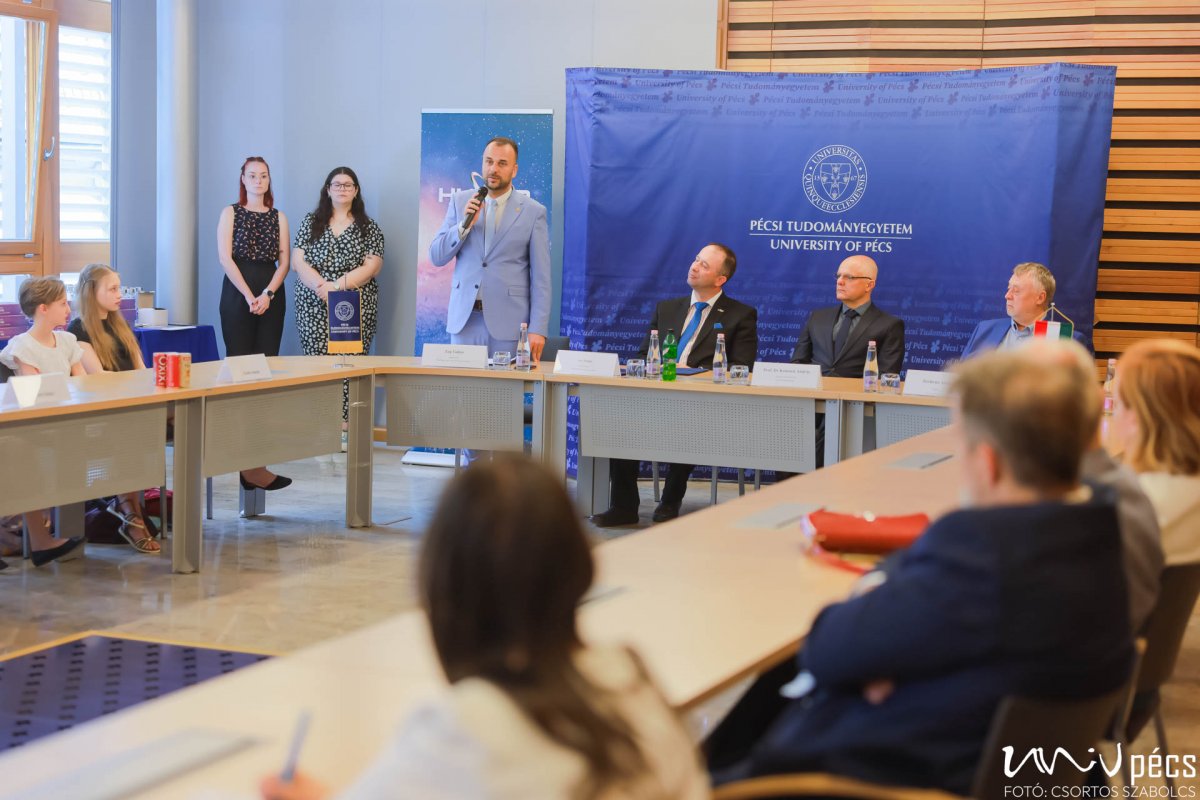
On behalf of the city of Pécs, Deputy Mayor Gábor Zag greeted and congratulated the winners.
“Dare to dream big,
dare to go in the direction of wanting to invent something and wanting to make it happen… This project supports just that,” said the Deputy Mayor, who added that he sincerely believes that the project that the students and alumni have implemented is just the beginning of something, and he hopes that they will continuously develop it further, hoping that they will choose a career in research.
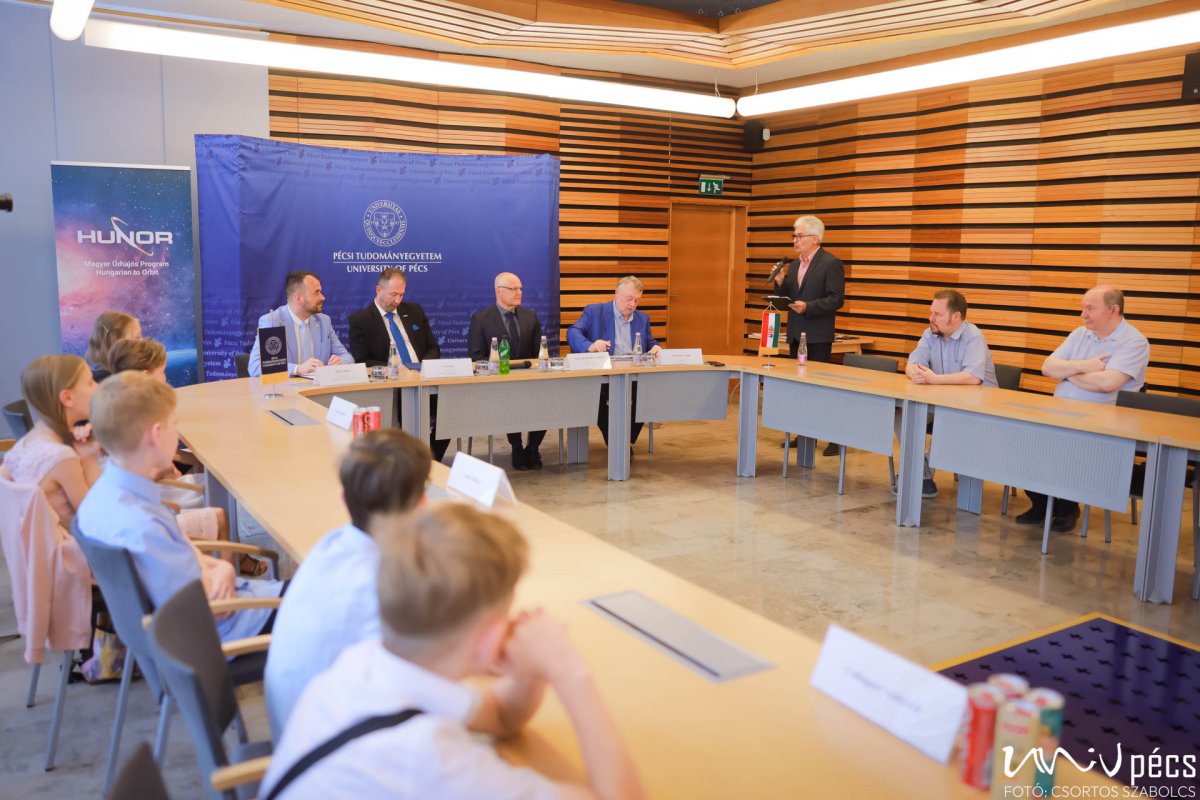
The project's initiator and manager, Gábor Horzsa, recalled the initial period and his meeting with the PTE Chancellor, István Decsi, and Dr. Orsolya Ferencz, Ministerial Commissioner for Space Research and Member of Parliament. In his speech, he highlighted the role of the jury of the John von Neumann Computer Society and thanked his colleagues for their excellent work.
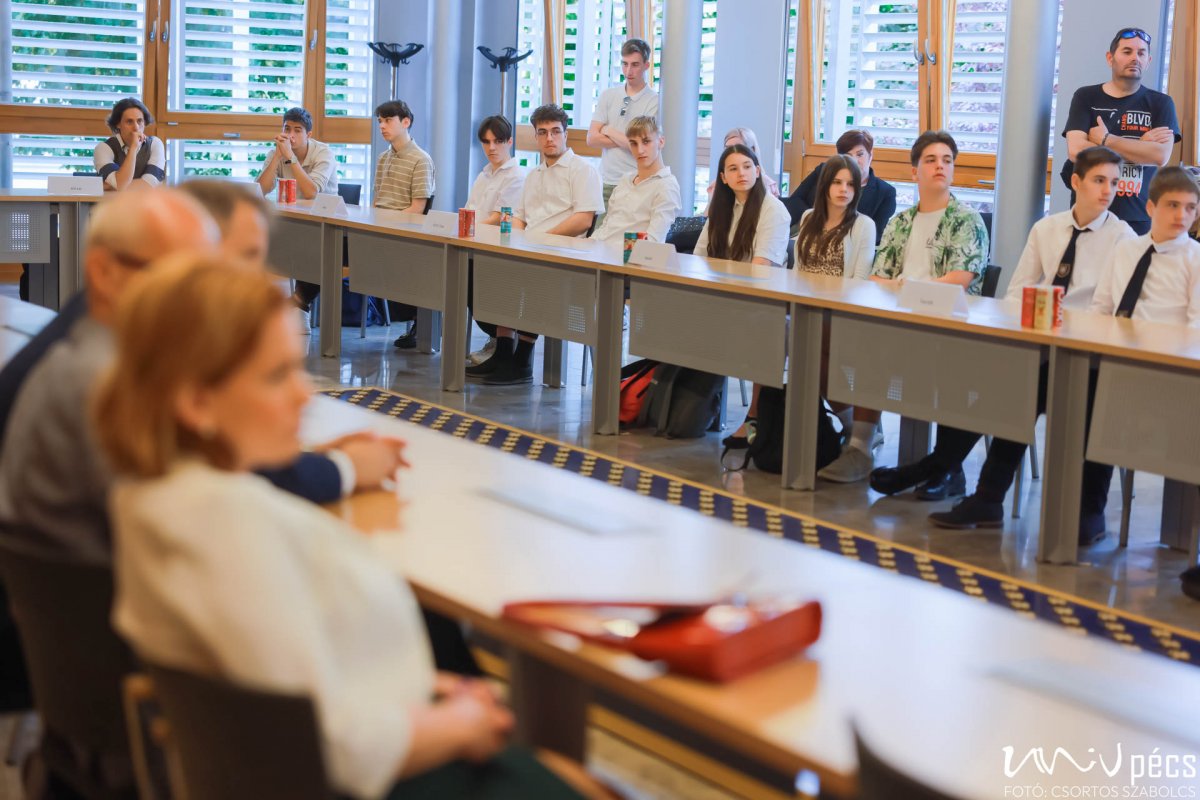
The top three winners in each age group were awarded prizes, and not just any prizes: the first-place winners received 400,000 forints, the second-place winners received 350,000 forints, and the third-place winners received a high-quality computer equipment package worth 300,000 forints.
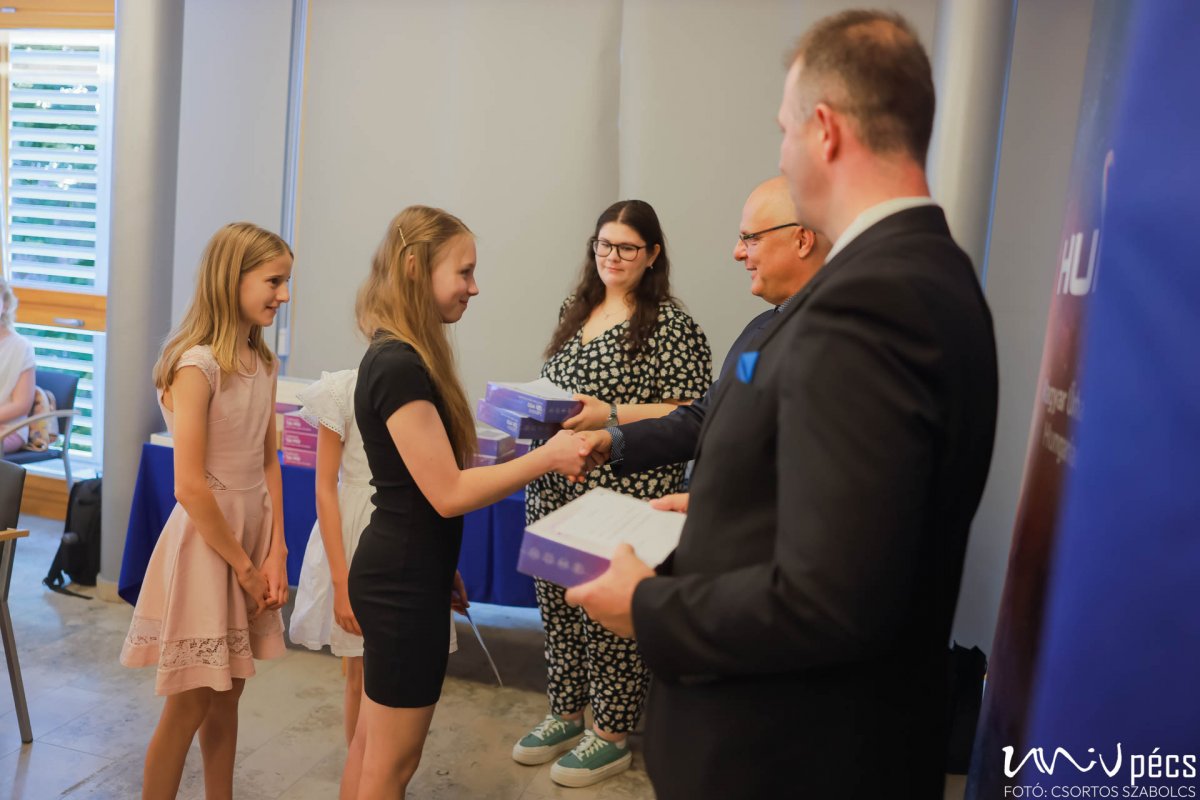
Awardees:
Grades 5-6
1st place: Musical Rockets
The team developed a detailed and well-thought-out project aimed at creating living conditions on the Moon. The Shackleton Crater was chosen as the central element, not by chance: its geographical location is ideal for ensuring water and energy needs. The team proposed complex solutions for oxygen production, plant cultivation, and protection against cosmic radiation, in other words, the basic conditions for survival.
2nd place: Balázs André
The computer game based on the theme of "An alien civilization attacks Earth" is a truly complex and captivating creation, skillfully combining the curiosity of space exploration with the technical precision of programming. The game's intuitive menu system and thoughtful gameplay make the complex story and mechanics easy to understand, while the careful use of licensed graphic elements and sound effects represents a high standard.
3rd place: Stardust hunters
This project takes a creative and innovative approach to building a Mars base, while also conveying a strong sustainability message by recycling household waste. The model’s detailed design and thoughtful functional elements – such as the greenhouse, water treatment system, waste management unit and space center – authentically reflect the challenges of the Martian environment, while also outlining practical solutions for the sustainability of life on a distant planet.
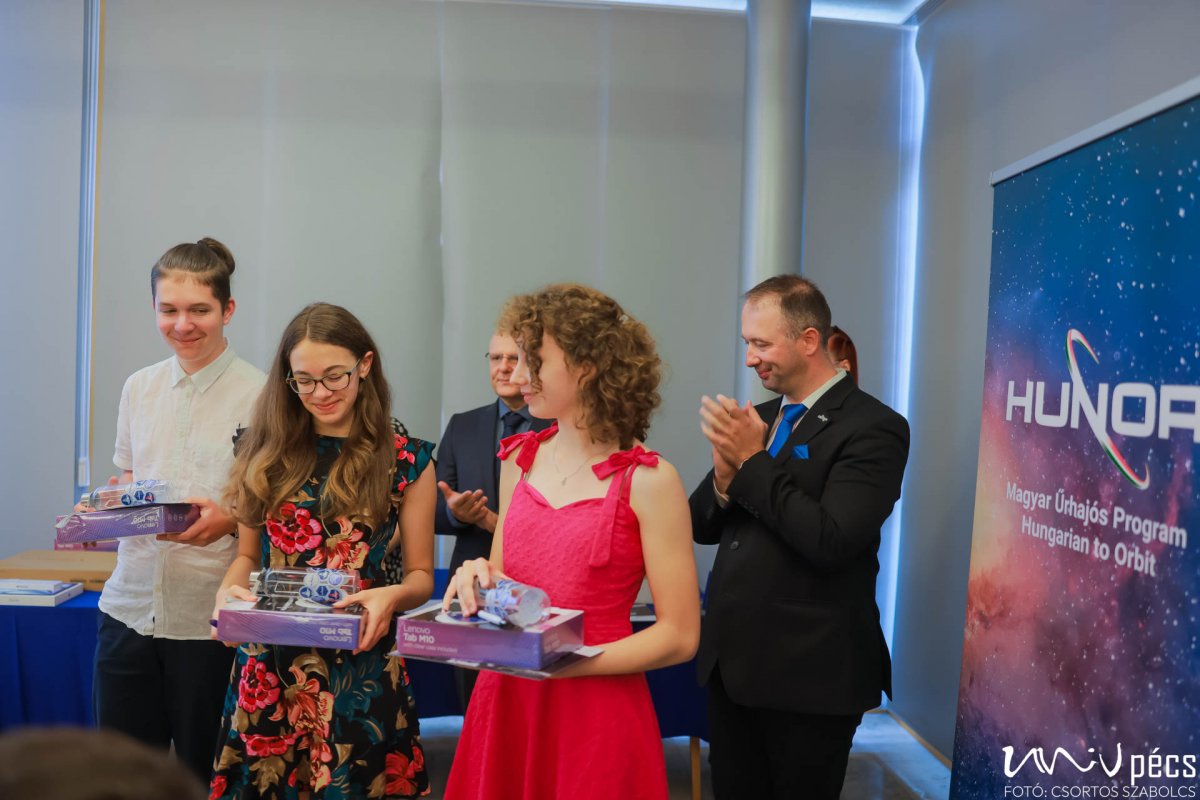
Grades 7-8
1st place: Bartók: Microcosm
The team has developed an ambitious plan to make Mars habitable in the next hundred years, focusing on Gale Crater, which would be covered by a huge dome. The project explores two bold, innovative solutions to restore Mars' atmosphere: one is to restart the planet's internal heat production, and the other is to install an electromagnetic shield. The plan covers in detail the creation of living conditions - oxygen supply, land use and energy sources - as well as the steps for establishing a human colony.
2nd place: ton 618
The project is an interactive game that presents life on a spaceship and simulates an attack on Earth. The team built the main game on the GDevelop engine, adding classic games and their own 3D models.
3rd place: Astrio
The team dreamed up a bold and innovative project that would open the door to a holiday on the Moon for ordinary people. They worked out in detail the conditions for lunar life: a protective shell against the lack of atmosphere, a reliable oxygen supply, special clothing, a food and water supply, and a solar-based power source. The vacationers' experiences will be enriched by lunar rover tours, zero-gravity competitions, space fashion shows, and an interactive museum, all of which offer unique programs in an alien environment.
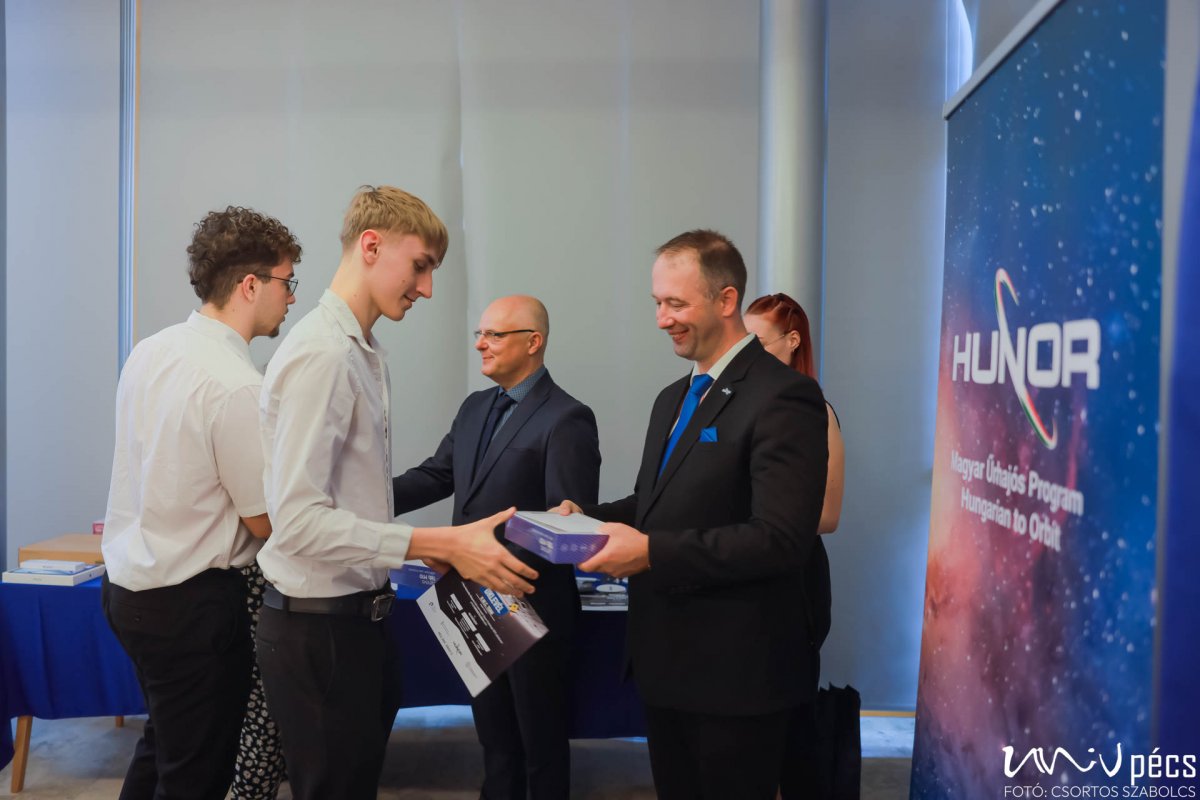
Grade 9-12
1st place: H.M.C.Team
The H.M.C Team's “Apollo24” project offers a sophisticated, practical solution to the growing problem of space debris. The team created a universal tracked robot base and a programmed drone that can work together to efficiently collect space debris both on land and in the air. During development, they used their own CoDrone and EV3 robots, while supporting their research with NASA data.
2nd place: Fallen
The project is a Windows-based C# application that evaluates the habitability of celestial bodies based on various environmental parameters, such as gravity, temperature, air pressure, and oxygen levels, using a clear scoring system. The program not only analyzes the data precisely, but also displays the results visually in pie charts, while saving the analyses in separate files, making the data easy to retrieve and compare.
3rd place: Galactic Garbage Crew
The project presents an independently operating satellite system that offers an effective solution for collecting space debris. The system uses cameras and laser sensors to identify debris, then collects it with an electrostatic net, which it then slows down and safely returns to the atmosphere for destruction. Power is supplied by solar panels, and maneuvering is enabled by an ion engine, making the solution technologically sound and innovative.
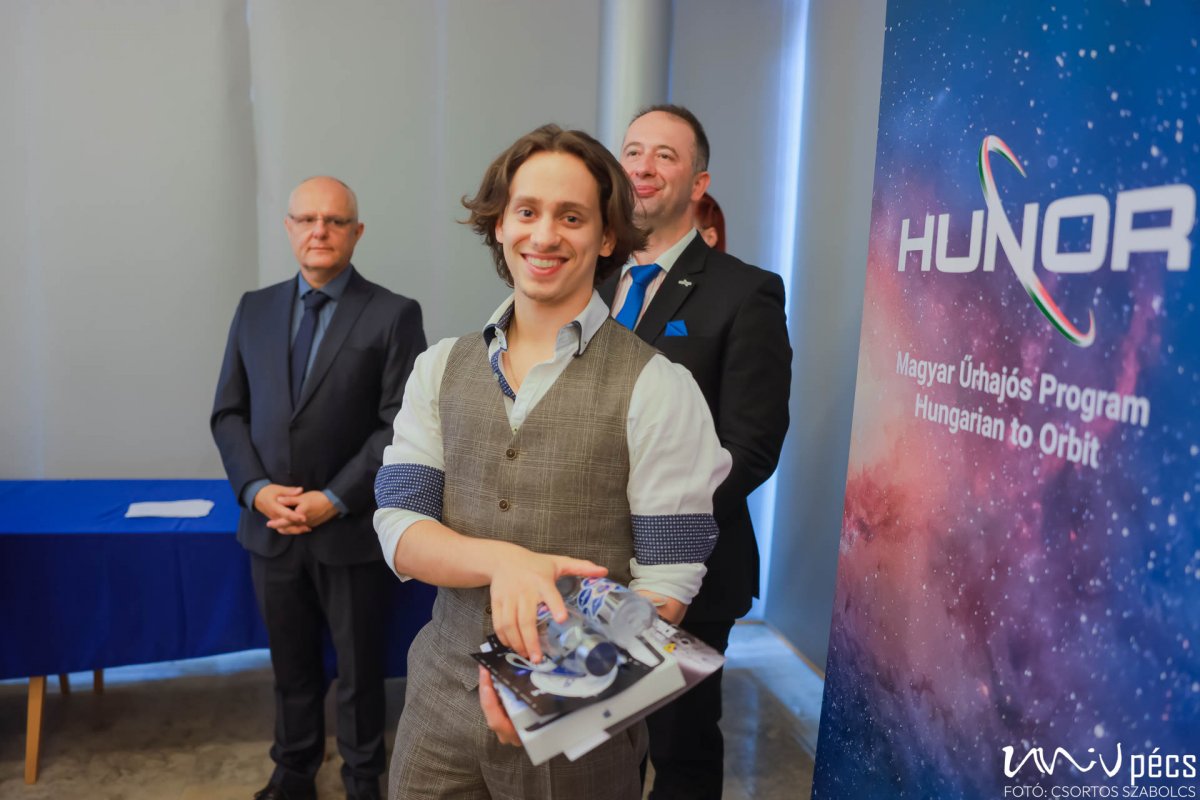
University students
1st place: HÖLD
The HÖLD project is developing an original and forward-looking approach to dealing with extreme temperature fluctuations on the Moon, especially during long, freezing night periods. The team has designed an innovative heat storage system that uses local regolith and solar energy collectors, while filling the porous structure of the regolith with argon gas to make heat transfer more efficient.
2nd place: Armada
The project aims to develop a pharmacological method to increase muscle mass in astronauts living in space. The thesis is based on solid scientific foundations and uses reliable sources, but the method presented is still theoretical at this stage. The idea is exciting and has great potential, but rigorous clinical validation is required before practical application.
3rd place: WHEREISTHESPACE
The project involves the development of a complex computer game.
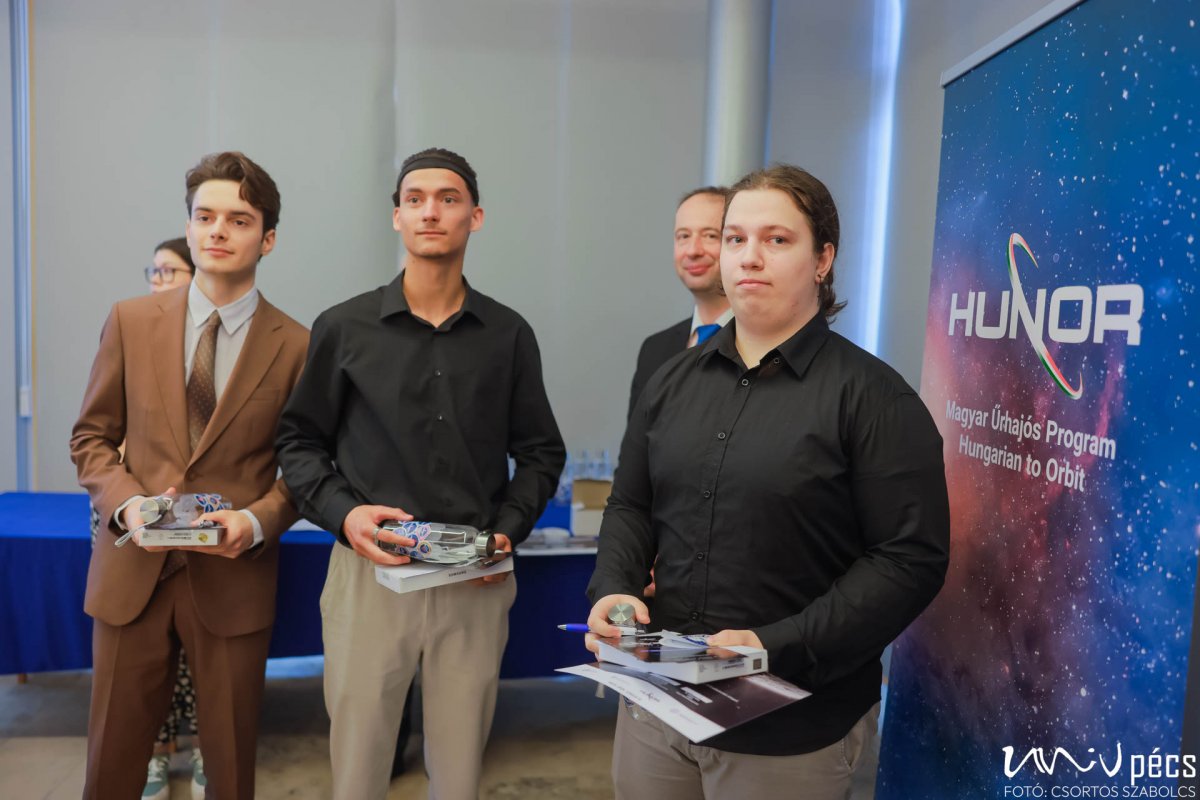
People's Choice Award: TAMASO
The TAMASO team has developed an innovative smart clothing concept to combat muscle loss during space travel. The built-in sensors of the body-hugging suit detect the direction of movement and then stimulate the opposite muscle group with resistance, providing active training and helping to maintain muscle strength even in weightlessness.
Congratulations to the winners!
If you are interested in space, visit the HUNIVERZUM: Hungarians in Space interactive experience center at Millenáris, which is open until October 31.
- Log in to post comments
University of Pécs | Chancellery | IT Directorate | Portal group - 2020.
